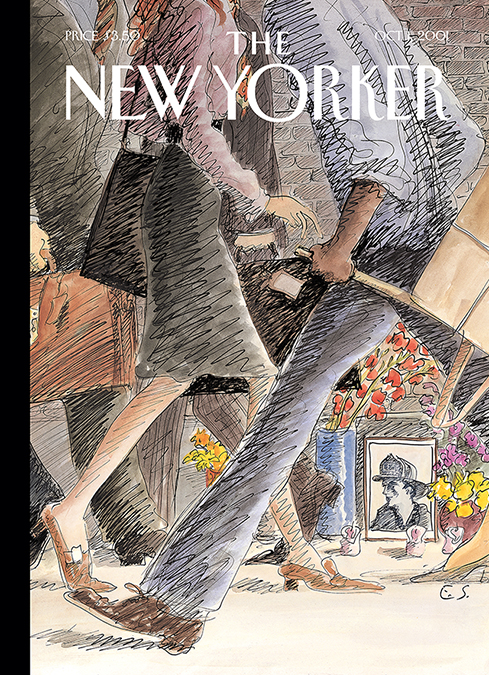Make a donation to the museum
Moving Forward After Tragedy
Moving Forward After Tragedy
- Grades 6 to 8
- Lesson Duration: one class period
- Theme: Memorializing 9/11
Essential Question: How do communities move forward after a tragic event?
Learning Goals
Students will examine a piece of evidence showing how New Yorkers reacted in the immediate aftermath of the 9/11 attacks.
Students will consider why and how a society moves forward after a tragic event.
Students will assess the potential dangers of moving on too quickly.
Vocabulary
The New Yorker magazine: This weekly publication provides reporting and commentary on politics, foreign affairs, business, technology, popular culture, and the arts, along with humor, fiction, poetry, and cartoons.
Stuyvesant High School: This high school is located a few blocks away from the World Trade Center.
FDNY: This is an abbreviation for the Fire Department of New York. On 9/11, 343 active-duty FDNY firefighters were killed responding to the attacks.
NYPD: This is an abbreviation for the New York City Police Department. Twenty-three NYPD officers were killed on 9/11.
PAPD: This is the law enforcement arm of the Port Authority, an agency run by New York and New Jersey that oversees many facilities shared by the two states, including airports, bridges, tunnels, and the World Trade Center. Thirty-seven PAPD officers were killed on 9/11.

“Street Scene,” 2001, Edward Sorel, Courtesy of The New Yorker © Condé Nast
Activity
1. Display or distribute copies of The New Yorker cover titled “Street Scene.” Click on the image to use the pinch-and-zoom feature for closer viewing.
2. Ask students to look at the cover and write down any details they notice or share as a class. If working in small groups, direct students to share responses with classmates.
3. Lead a guided inquiry by asking the following questions and record their observations on a smart board or chart paper by category.
- What are the people doing? What objects do you notice? What makes you say that?
- When was this made? Why might that be important?
- Where does this take place? What makes you say that?
- Describe the people you see on the cover. Who else do you see?
4. Recap the recorded responses from students. Ask students how they would describe what’s going on in the cover to someone who cannot see it. How does the cover or what’s happening on it make them feel?
5. Tell students this cover is connected to immediate aftermath of the 9/11 attacks in 2001. In order to get a better sense of what people were feeling and thinking right after the attacks, students will investigate a primary source.
6. Share “Statement by President George W. Bush in His Address to the Nation.” As students read, direct them to circle anything that provides information about immediate concerns and responses to the 9/11 attacks. Have students share their findings.
7. Share with students that a big question after 9/11 was how Americans move on with their lives after such a tragic event.
8. For many, shared events were ways that helped people return to a sense of normalcy after the attacks. Ask students to examine the timeline below and consider why these events might be important:
September 13, 2001: Broadway theater performances resume, with dimmed marquees honoring the 9/11 victims.
September 17, 2001: Starting with a moment of silence, the New York Stock Exchange opens for the first time since the close of business on September 10. Members of the FDNY, NYPD, and PAPD ring the opening bell.
September 17, 2001: After being canceled for six days, Major League Baseball resumes when the New York Mets play in Pittsburgh, Pennsylvania. Defying league regulations, Mets players wear NYPD and FDNY caps throughout the season.
September 29, 2001: Saturday Night Live returns for its 21st season.
October 9, 2001: Students at Stuyvesant High School in lower Manhattan return to their school building.
October 20, 2001: Celebrities and many in the entertainment industry participate in The Concert for New York City, a five-hour benefit concert held at Madison Square Garden and broadcast internationally.
November 4, 2001: The New York City Marathon takes place as scheduled.
9. Watch the clip below with Bernie Williams, a former outfielder for the New York Yankees, discussing playing baseball in the aftermath of the attacks. He describes the team having a “mission.” Ask students:
- What does he mean? What role did baseball play for him and the city?
Video: Bernie Williams Public Program Excerpt
10. Conclude by playing the clip below of Olympian Deena Kastor, a record-holding long-distance runner. Discuss with students what she means by “resiliency is in our DNA.” Why is it important to move forward after a tragic event? How can a tragedy be used to make us, as individuals and communities, stronger?